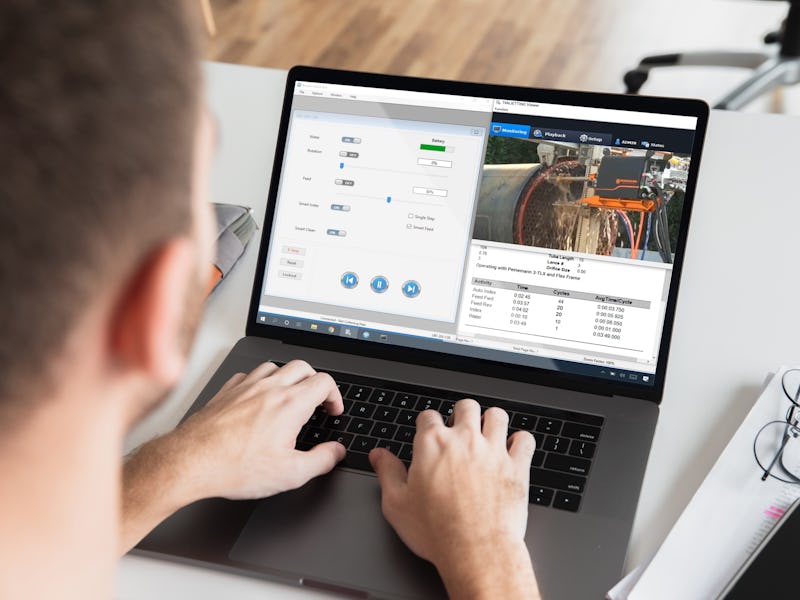How one company learned robots can be used for good in a blue-collar industry
“Ultimately, it evolves the worker's job, but does not eliminate their employment.”

One aspect of keeping business going is … keeping things clean. That’s especially important for industrial workplaces in industries such as oil and gas, chemicals, and bio-energy.
Typically, industrial cleaners would have to be on-site to perform the dirty job of cleaning, but stay-at-home orders have actually encouraged innovations in the industry. Terry Gromes, Jr., director of strategic technologies at Terydon Inc., explains in the Q&A below.
What do you do?
Terydon manufactures a product line of automated robotics controlled wirelessly by computerized devices, specifically for cleaning with ultra-high pressure water in the energy sector. This is often called “waterjetting,” “hydrojetting,” or “waterblasting.” Our products are built upon smart technology such as machine learning and internet of things to create safer and more productive cleanings for industries ranging from oil/gas (Exxon Mobil, Shell), chemical (Dow Chemical, BASF), bio-energy (Flint Hills Resources, Valero), and more.
These companies’ systems inevitably need to be shut down due to byproduct buildup through their processes. It costs these asset owners millions of dollars per day to be down, so it is important for the cleaning processes to be as productive as possible in order to get operations back up and running. Whereas common methods include bulky standalone control pendants that provide an air command through pneumatic lines, our patented control through wireless computerized devices makes our industry approach unique.
How have you conducted business in the past?
The industrial cleaning industry as a whole is a very hazardous, labor-intensive job. Much of the work leaves the worker in direct contact with the debris being removed. This can cause burns to the skin and be harmful or fatal if ingested or inhaled. Also, the high-pressure water comes with high risks — the pressures are high enough to cut through solid steel. As a result, injuries and fatalities are sadly an everyday risk.
Our wireless robotic solutions provide a cleaning method where the operator can be safely removed from the hazardous “blast zone” and still complete the cleaning application. Prior to lockdowns, however, it has been an industry standard to keep the operator within the cleaning vicinity to have direct line-of-sight with the process. Therefore, Bluetooth control through an Android touchscreen tablet has been the standard method of wireless control for these applications, as this can safely keep the operator 20 to 30 feet away from the application yet still keep them in the vicinity.
What immediate effects did stay-at-home orders have on your business?
As a result of stay-at-home orders, this created a tense situation where end users could not enter the asset owner facilities to perform maintenance and cleaning. This created a high-risk scenario for the asset owners, where extended down time could cost them millions of dollars.
“The beauty of working in a tech-forward society is that it is constantly changing, evolving, and becoming more readily available.”
What changes did you make to adapt to our current situation?
Changes we made to adapt was to expand our control platform to include remote operations to abide by the work-from-home restrictions. This included incorporating wireless control beyond Bluetooth to extend farther through wifi and cellular networks, as well as remote video monitoring. As a form of “tele-robotics,” we have called this “tele-jetting” by combining tele-robotics and waterjetting cleaning methods.
What were the challenges in implementing these changes?
The challenges of introducing new technologies within industrial cleaning often results in resistance due to the fear that “automation” will take away workers’ jobs. We had to educate the industry that “automation” can be more productive than people due to the fact that it can repeat predictable and repetitive actions without getting tired, but the worker is still the critical piece to making these machines productive through “teaching” the machine and providing preventative maintenance. Ultimately, it evolves the worker's job, but does not eliminate their employment.
What have been the results?
The results have been successful, though have been implemented out of necessity. We are optimistic that in the future they will continue to be used out of efficiency. Our data that is collected during these processes show that these robotic solutions are considerably more productive than prior methods. In an industry where the turnover rate of employment is commonly high, these skilled “WFH” operators can be based practically anywhere.
What have you learned through adapting to a remote environment?
Needless to say, the WFH environment changes considerably from what the typical industry worker experiences. On site, there is standardized PPE and safety gear that must be worn at all times, and safety protocol that varies from asset owner site and location. (Think extreme heat of 115-plus degrees F in the Gulf Coast versus extreme cold of -40 degrees F in northern Alberta.) Remotely operating this equipment from home or an office provides a controlled environment that removes the worker from the elements that are commonly associated with working in industrial cleaning. This, along with the modern computer technology, will attract members of the millennial and gen-Z workforce into an industry that has previously been viewed as blue collar and labor intensive. These individuals have grown up with smartphones, tablets, and computers in their hands, so they would be more likely to embrace these tech-forward solutions.
What advice do you have for others who are trying to figure out this new way or working?
The beauty of working in a tech-forward society is that it is constantly changing, evolving, and therefore becoming more readily available and cost-effective. Touchscreen tablets that were made rugged for our industry when we began down this route cost upwards of $5,000. Now, these acceptable tablets are available for less than $500 on Amazon with free two-day shipping. All it takes is a creative mind to apply it to your specific industry!
This article was originally published on